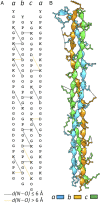How electrostatic networks modulate specificity and stability of collagen
- PMID: 29844169
- PMCID: PMC6004475
- DOI: 10.1073/pnas.1802171115
How electrostatic networks modulate specificity and stability of collagen
Erratum in
-
Correction to Supporting Information for Zheng et al., How electrostatic networks modulate specificity and stability of collagen.Proc Natl Acad Sci U S A. 2018 Jun 26;115(26):E6098. doi: 10.1073/pnas.1809680115. Epub 2018 Jun 18. Proc Natl Acad Sci U S A. 2018. PMID: 29915038 Free PMC article. No abstract available.
Abstract
One-quarter of the 28 types of natural collagen exist as heterotrimers. The oligomerization state of collagen affects the structure and mechanics of the extracellular matrix, providing essential cues to modulate biological and pathological processes. A lack of high-resolution structural information limits our mechanistic understanding of collagen heterospecific self-assembly. Here, the 1.77-Å resolution structure of a synthetic heterotrimer demonstrates the balance of intermolecular electrostatics and hydrogen bonding that affects collagen stability and heterospecificity of assembly. Atomistic simulations and mutagenesis based on the solved structure are used to explore the contributions of specific interactions to energetics. A predictive model of collagen stability and specificity is developed for engineering novel collagen structures.
Keywords: cooperativity; molecular dynamics; protein design; self-assembly; triple helix.
Conflict of interest statement
The authors declare no conflict of interest.
Figures






Similar articles
-
Self-assembled heterotrimeric collagen triple helices directed through electrostatic interactions.J Am Chem Soc. 2007 Mar 7;129(9):2683-90. doi: 10.1021/ja0683640. Epub 2007 Feb 13. J Am Chem Soc. 2007. PMID: 17295489
-
Surprisingly high stability of collagen ABC heterotrimer: evaluation of side chain charge pairs.J Am Chem Soc. 2007 Dec 5;129(48):15034-41. doi: 10.1021/ja075854z. Epub 2007 Nov 8. J Am Chem Soc. 2007. PMID: 17988128
-
De novo self-assembling collagen heterotrimers using explicit positive and negative design.Biochemistry. 2010 Mar 23;49(11):2307-16. doi: 10.1021/bi902077d. Biochemistry. 2010. PMID: 20170197 Free PMC article.
-
Pairwise interactions in collagen and the design of heterotrimeric helices.Curr Opin Chem Biol. 2013 Dec;17(6):960-7. doi: 10.1016/j.cbpa.2013.10.019. Epub 2013 Nov 16. Curr Opin Chem Biol. 2013. PMID: 24252327 Review.
-
Mechanics and structural stability of the collagen triple helix.Curr Opin Chem Biol. 2019 Dec;53:98-105. doi: 10.1016/j.cbpa.2019.08.001. Epub 2019 Oct 11. Curr Opin Chem Biol. 2019. PMID: 31606538 Review.
Cited by
-
Highly Water-Preserving Zwitterionic Betaine-Incorporated Collagen Sponges With Anti-oxidation and Anti-inflammation for Wound Regeneration.Front Cell Dev Biol. 2020 Jul 15;8:491. doi: 10.3389/fcell.2020.00491. eCollection 2020. Front Cell Dev Biol. 2020. PMID: 32766236 Free PMC article.
-
Recent trends in protein and peptide-based biomaterials for advanced drug delivery.Adv Drug Deliv Rev. 2020;156:133-187. doi: 10.1016/j.addr.2020.08.008. Epub 2020 Aug 29. Adv Drug Deliv Rev. 2020. PMID: 32871201 Free PMC article. Review.
-
Evidence for Quantum Chemical Effects in Receptor-Ligand Binding Between Integrin and Collagen Fragments - A Computational Investigation With an Impact on Tissue Repair, Neurooncolgy and Glycobiology.Front Mol Biosci. 2021 Nov 16;8:756701. doi: 10.3389/fmolb.2021.756701. eCollection 2021. Front Mol Biosci. 2021. PMID: 34869589 Free PMC article.
-
Contrasting Local and Macroscopic Effects of Collagen Hydroxylation.Int J Mol Sci. 2021 Aug 23;22(16):9068. doi: 10.3390/ijms22169068. Int J Mol Sci. 2021. PMID: 34445791 Free PMC article.
-
Composition-dependent energetic contribution of complex salt bridges to collagen stability.Biophys J. 2021 Aug 17;120(16):3429-3436. doi: 10.1016/j.bpj.2021.05.028. Epub 2021 Jun 25. Biophys J. 2021. PMID: 34181903 Free PMC article.
References
-
- Heino J. The collagen family members as cell adhesion proteins. Bioessays. 2007;29:1001–1010. - PubMed
-
- Tolstoshev P, Haber R, Crystal RG. Procollagen alpha2 mRNA is significantly different from procollagen alpha1(I) mRNA in size or secondary structure. Biochem Biophys Res Commun. 1979;87:818–826. - PubMed
-
- Johansson C, Butkowski R, Wieslander J. The structural organization of type IV collagen. Identification of three NC1 populations in the glomerular basement membrane. J Biol Chem. 1992;267:24533–24537. - PubMed
Publication types
MeSH terms
Substances
Associated data
- Actions
LinkOut - more resources
Full Text Sources
Other Literature Sources

